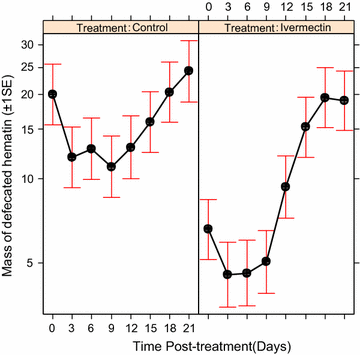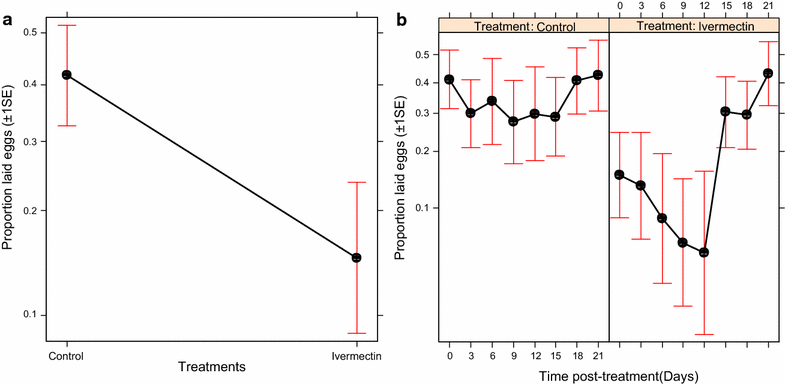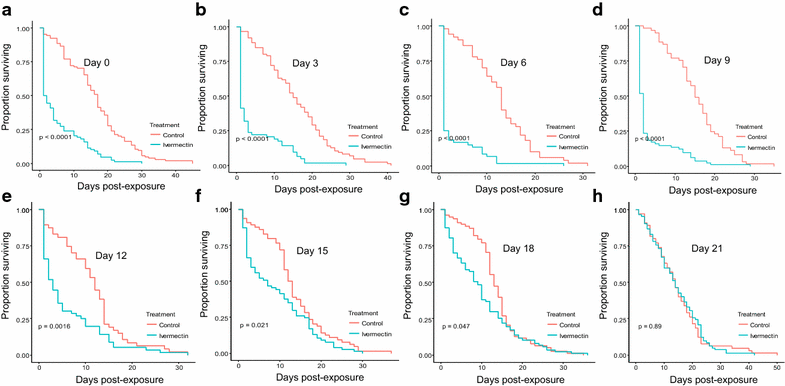Ivermectin-treated cattle reduces blood digestion, egg production and survival of a free-living population of Anopheles arabiensis under semi-field condition in south-eastern Tanzania
- PMID: 28587669
- PMCID: PMC5461717
- DOI: 10.1186/s12936-017-1885-x
Ivermectin-treated cattle reduces blood digestion, egg production and survival of a free-living population of Anopheles arabiensis under semi-field condition in south-eastern Tanzania
Abstract
Background: Anopheles arabiensis feed on cattle and contributes to residual transmission of malaria in areas with high coverage of long-lasting insecticide-treated nets and indoor residual spraying in East Africa. This study aimed to evaluate the effects of ivermectin-treated cattle as a complementary vector control tool against population of An. arabiensis under the semi-field conditions in south-eastern Tanzania.
Methods: The free-living population of An. arabiensis was allowed to forage on untreated or ivermectin-treated cattle in alternating nights within the semi-field system in south-eastern Tanzania. Fresh blood fed mosquitoes were collected in the morning using mouth aspirators and assessed for their blood meal digestion, egg production, and survivorship. The residual activity of ivermectin-treated cattle was also determined by exposing mosquitoes to the same treatments after every 2 days until day 21 post-treatments. These experiments were replicated 3 times using different individual cattle.
Results: Overall, the ivermectin-treated cattle reduced blood meal digestion in the stomach of An. arabiensis, and their subsequent egg production and survival over time. The ivermectin-treated cattle halved blood meal digestion in mosquitoes, but reduced their egg production for up to 15 days. The ivermectin-treated cattle reduced the survival, and median survival times (1-3 days) of An. arabiensis than control cattle. The daily mortality rates of mosquitoes fed on ivermectin-treated cattle increased by five-fold relative to controls in the first week, and it gradually declined up to 21 days after treatment.
Conclusion: This study demonstrates that long-lasting effects of ivermectin-treated cattle on egg production and survival of An. arabiensis may sustainably suppress their vector density, and reduce residual transmission of malaria. This study suggests that ivermectin-treated non-lactating cattle (i.e. calves, heifers and bulls) could be suitable option for large-scale malaria vector control without limiting consumption of milk and meat by communities in rural settings. Furthermore, simulation models are underway to predict the impact of ivermectin-treated cattle alone, or in combination with LLIN/IRS, the frequency of treatment, and their coverage required to significantly suppress population of An. arabiensis and reduce residual transmission of malaria.
Keywords: Anopheles arabiensis; Blood-digestion; Cattle; Egg-production; Exophagy; Haematin; Ivermectin; Residual-transmission; Survival; Vector–control; Zoophagy.
Figures






Similar articles
-
The effect of cattle-administered ivermectin and fipronil on the mortality and fecundity of Anopheles arabiensis Patton.Parasit Vectors. 2021 Jul 2;14(1):349. doi: 10.1186/s13071-021-04846-8. Parasit Vectors. 2021. PMID: 34215295 Free PMC article.
-
Treatment of livestock with systemic insecticides for control of Anopheles arabiensis in western Kenya.Malar J. 2015 Sep 17;14:351. doi: 10.1186/s12936-015-0883-0. Malar J. 2015. PMID: 26377691 Free PMC article.
-
Effect of Ivermectin® on survivorship and fertility of Anopheles arabiensis in Ethiopia: an in vitro study.Malar J. 2023 Jan 9;22(1):12. doi: 10.1186/s12936-023-04440-6. Malar J. 2023. PMID: 36624480 Free PMC article.
-
Ivermectin to reduce malaria transmission III. Considerations regarding regulatory and policy pathways.Malar J. 2017 Apr 24;16(1):162. doi: 10.1186/s12936-017-1803-2. Malar J. 2017. PMID: 28434407 Free PMC article. Review.
-
Ivermectin to reduce malaria transmission II. Considerations regarding clinical development pathway.Malar J. 2017 Apr 24;16(1):166. doi: 10.1186/s12936-017-1802-3. Malar J. 2017. PMID: 28434405 Free PMC article. Review.
Cited by
-
Emergence of behavioural avoidance strategies of malaria vectors in areas of high LLIN coverage in Tanzania.Sci Rep. 2020 Sep 3;10(1):14527. doi: 10.1038/s41598-020-71187-4. Sci Rep. 2020. PMID: 32883976 Free PMC article.
-
Sugar restriction and blood ingestion shape divergent immune defense trajectories in the mosquito Aedes aegypti.Sci Rep. 2023 Jul 31;13(1):12368. doi: 10.1038/s41598-023-39067-9. Sci Rep. 2023. PMID: 37524824 Free PMC article.
-
Measuring effects of ivermectin-treated cattle on potential malaria vectors in Vietnam: A cluster-randomized trial.PLoS Negl Trop Dis. 2024 Apr 29;18(4):e0012014. doi: 10.1371/journal.pntd.0012014. eCollection 2024 Apr. PLoS Negl Trop Dis. 2024. PMID: 38683855 Free PMC article. Clinical Trial.
-
BOHEMIA: Broad One Health Endectocide-based Malaria Intervention in Africa-a phase III cluster-randomized, open-label, clinical trial to study the safety and efficacy of ivermectin mass drug administration to reduce malaria transmission in two African settings.Trials. 2023 Feb 21;24(1):128. doi: 10.1186/s13063-023-07098-2. Trials. 2023. PMID: 36810194 Free PMC article. Clinical Trial.
-
Acaricidal efficacy of orally administered macrocyclic lactones against poultry red mites (Dermanyssus gallinae) on chicks and their impacts on mite reproduction and blood-meal digestion.Parasit Vectors. 2019 Jul 12;12(1):345. doi: 10.1186/s13071-019-3599-0. Parasit Vectors. 2019. PMID: 31300011 Free PMC article.
References
-
- WHO . World malaria report. Geneva: World Health Organization; 2016.
-
- Russell T, Lwetoijera D, Maliti D, Chipwaza B, Kihonda J, Charlwood JD, et al. Impact of promoting longer-lasting insecticide treatment of bed nets upon malaria transmission in a rural Tanzanian setting with pre-existing high coverage of untreated nets. Malar J. 2010;9:187. doi: 10.1186/1475-2875-9-187. - DOI - PMC - PubMed
Publication types
MeSH terms
Substances
LinkOut - more resources
Full Text Sources
Other Literature Sources

